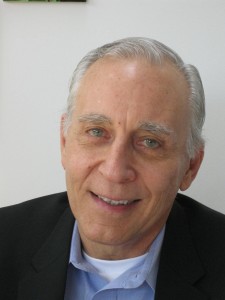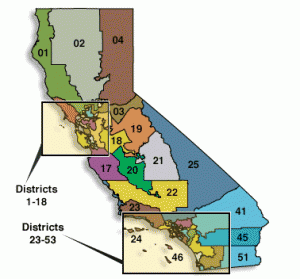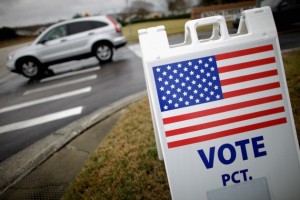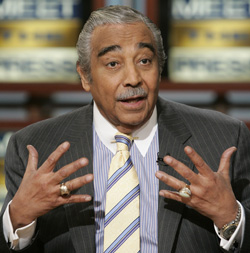By Ron Kahlow, on Wed Oct 24, 2012 at 10:00 AM ET  Many voters are frustrated and outraged by the $6 billion being spent in deceptive political advertising, attack ads, and robo calls. Unfortunately, there is only a meager counter balance to this massive expenditure. Many voters are frustrated and outraged by the $6 billion being spent in deceptive political advertising, attack ads, and robo calls. Unfortunately, there is only a meager counter balance to this massive expenditure.
Only three organizations — Project Vote Smart, League of Women Voters, and Vote USA — currently are available to provide voters with non-partisan information. A fourth, eVoter.com, recently terminated due to lack of money. The three still standing attempt to provide voters what they need to vote their interests, not those of special interests groups spending the $6 Billion. Unfortunately, all three are grossly underfunded and out gunned. Yes, voters may only have a sling shot against this Moneyed Goliath but, if they use it well, it may make a substantial difference.
The first, League of Women Voters (LWV.org) is a league of 51 different LWV organizations, one for each state and DC. It was founded in 1920 to ratify the 19th amendment to the U.S. Constitution providing women the right to vote at the convention of the National American Woman Suffrage Association. League members were encouraged to be political themselves, by educating citizens about, and lobbying for, government and social reform legislation. Another objective is to provide non-partisan voter information and, for decades, LWV has been mailing sample ballots to voters. With the advent of the Internet, LWV developed a single Vote411 website where it attempts to provide voters with targeted information about the candidates in each voter’s various Federal and State contests. When this information is not available on its website (probably due to redistricting), it provides links to State and county voter guides.
Read the rest of…
Ron Kahlow: The Meager Counter Balance to Money in Politics
By Ron Kahlow, on Fri Oct 19, 2012 at 10:00 AM ET  In June 2010 via Proposition 14, California radically changed the way candidates are elected to public office. Previously, candidates running for office appeared only on their party’s ballot in the primary election. Then, the winner from each political party and any independents who qualified for ballot access would move on to the general election. Then, for the general election in November, voters could choose between one Republican, one Democrat, and any number of third party and independent candidates for almost every office contest. In June 2010 via Proposition 14, California radically changed the way candidates are elected to public office. Previously, candidates running for office appeared only on their party’s ballot in the primary election. Then, the winner from each political party and any independents who qualified for ballot access would move on to the general election. Then, for the general election in November, voters could choose between one Republican, one Democrat, and any number of third party and independent candidates for almost every office contest.
Proposition 14 changed all that. Now, under the “Top-Two Open Primary Act,” all candidates desiring to run for public office, regardless of party affiliation or preference, will appear on a single combined ballot in the primary election. Likewise, all voters, regardless of party affiliation or preference, are permitted to vote for any candidate on this combined ballot. Then, only the two candidates who receive the highest and second-highest number of votes move on to the general election. So, for the general election in November, voters can only choose between two candidates. Both candidates could be in the same party, different parties, or with any combination with independent candidates. Also, the candidates can choose whether or not to list their party affiliation on the primary and general election ballots. In other words, the top two overall vote-getters, not the top vote-getter from each political party, get on the general election ballot.
 Interestingly, the change does not apply to all offices. It only includes State-oriented offices, like U.S. Senate, U.S. House, State-wide offices, State Senate, and State House. It does not include U.S. President, county, and local offices. Nonetheless, the new election process could be a seismic change in California’s democratic process. But was it? Interestingly, the change does not apply to all offices. It only includes State-oriented offices, like U.S. Senate, U.S. House, State-wide offices, State Senate, and State House. It does not include U.S. President, county, and local offices. Nonetheless, the new election process could be a seismic change in California’s democratic process. But was it?
Counting the number of office contests where the candidates are, and are not, of the same party in the Vote-CA.org November 6, 2012 California General Election Report provides the answer.
Read the rest of…
Ron Kahlow: The Impact of California’s New Electoral System
By Ron Kahlow, on Tue Jun 26, 2012 at 1:30 PM ET  State primaries are in a truly very sad state. Voters don’t understand the importance of primaries. Voter turnout in every State primary has always been horrible. Primaries defeat the principle of representative democracy. Primaries give incumbents a big advantage over challengers. Next Tuesday, New York, Colorado, Oklahoma and Utah have primaries. And, the beat goes on. State primaries are in a truly very sad state. Voters don’t understand the importance of primaries. Voter turnout in every State primary has always been horrible. Primaries defeat the principle of representative democracy. Primaries give incumbents a big advantage over challengers. Next Tuesday, New York, Colorado, Oklahoma and Utah have primaries. And, the beat goes on.
One reason for poor turnout is that voters are often ignorant of the importance of primaries. For any office that is safe for a particular party, whoever wins the primary office contest has, in effect, already won the office. The office contest in the November general election is virtually meaningless. In the District of Columbia, almost all of the elected officials are Democrats. The primary election literally determines the DC government. The November DC election is a waste of time and money. Unfortunately many voters are unaware of this, and, by not showing up for the primary, they simply have no say in the selection of the candidate(s) who will represent them.
A second reason for poor turnout is that voters don’t understand primaries and are intimidated by them. Each State can hold a primary election in numerous ways. And, each State has its own rules in the actual execution of its primary. For voters, this makes for a confusing mess. They don’t know what party primary they can vote in. They don’t know how many different ballots there will be. They don’t know what party ballot(s) they can request. They don’t know what will be on the ballot(s). They don’t know what party identification they need. They simply don’t know what is going to happen when they show up at the polls. Worst of all, they can’t even get answers to these questions in advance on the State’s election website. I challenge you to try!
 In the case of next Tuesday, New York and Oklahoma will conduct ‘closed’ primaries. Voters may vote only if they are registered member of that party. Independent and non-partisan voters cannot participate. Colorado, however, will conduct a ‘semi-closed’ primary. Registered party members and unaffiliated voters can vote only in a party’s primary. Independents choose a party. But, Utah takes the prize. It will hold a ‘closed’ primary for registered Republicans but will hold ‘open’ primaries for Democrats and Constitution party members. Is it any wonder that voters are turned off by the whole business? In the case of next Tuesday, New York and Oklahoma will conduct ‘closed’ primaries. Voters may vote only if they are registered member of that party. Independent and non-partisan voters cannot participate. Colorado, however, will conduct a ‘semi-closed’ primary. Registered party members and unaffiliated voters can vote only in a party’s primary. Independents choose a party. But, Utah takes the prize. It will hold a ‘closed’ primary for registered Republicans but will hold ‘open’ primaries for Democrats and Constitution party members. Is it any wonder that voters are turned off by the whole business?
Read the rest of…
Ron Kahlow: The Sad State of State Primaries
By Ron Kahlow, on Thu Jun 21, 2012 at 3:00 PM ET  Who says primaries are not important? Tell that to the candidates and incumbents vying for New York’s US House seats. The 2010 census reduced the number of US House seats for New York from 29 to 27. The redistricting of these newly-redrawn districts means a new shuffling of the cards for the candidates and incumbents vying for these reduced number of US House races. Who says primaries are not important? Tell that to the candidates and incumbents vying for New York’s US House seats. The 2010 census reduced the number of US House seats for New York from 29 to 27. The redistricting of these newly-redrawn districts means a new shuffling of the cards for the candidates and incumbents vying for these reduced number of US House races.
In the 2010 primary, only 18% of voters turned out for the New York Primary. The turnout this year could be even worse because, in January, a Federal judge moved up the primary from Sept. 11 to June 26. New York voters became accustomed to having a primary after Labor Day. The change in date can only further hurt turnout. So, possibly fewer voters will determine who might be elected to Congress.
Currently three-quarters (21 of the 29) of New York’s U.S. House seats are currently held by Democrats and only one-quarter (8 of the 29) by Republicans. Of the 27 newly-created districts, there are 10 traditionally held Democratic seats (Districts 5, 6, 7, 8, 9, 13, 16, 18, 19, 23) being hotly contested. Many contests have between 3 to 5 candidates seeking a place on the November ballot. The Republicans will only have 5 contests on the primary ballot and they are a lot simpler with only 2 candidates in each contest. Three Republican US House district races are selecting a candidate who will attempt to unseat an incumbent Democrat. Two races are selecting a Republican for a traditionally-held Republican district. They also have three candidates hoping to unseat Democratic incumbent senator Kirsten Gillibrand.
Probably the most interesting contests in the New York Primary is New York’s 13th Congressional District, where Democrat Charles Rangel, who was the incumbent from the pre-redistricted 15th District now has to win the primary in the new 13th District. The old 15th District was basically the Harlem neighborhood. The new 13th District, which is still centered in Harlem, is no longer primarily African-American and has changed dramatically. The District has ballooned to cover all of Upper Manhattan, and extends into the Bronx. The old 15th District was close to 80% African-American, while the new 13th is only about 36% African-American and has a majority-Hispanic voting-age population.
 U.S. Representative Rangel has been in the U.S. House since 1971 (i.e., for 41 years) and is age 81. In 1971, he defeated Adam Clayton Powell Jr. by a razor-thin 300-vote margin but has won handily every election since, garnering over 95% of the vote in most elections. He is the third most senior member of the House and Chairman emeritus of the powerful Ways and Means Committee. That seniority has allowed him to deliver millions of dollars to Harlem. But, he now faces four challengers in the upcoming primary election. Whoever wins this primary contest probably will be elected to Congress in this Democratic District. U.S. Representative Rangel has been in the U.S. House since 1971 (i.e., for 41 years) and is age 81. In 1971, he defeated Adam Clayton Powell Jr. by a razor-thin 300-vote margin but has won handily every election since, garnering over 95% of the vote in most elections. He is the third most senior member of the House and Chairman emeritus of the powerful Ways and Means Committee. That seniority has allowed him to deliver millions of dollars to Harlem. But, he now faces four challengers in the upcoming primary election. Whoever wins this primary contest probably will be elected to Congress in this Democratic District.
In the new 13th District, Rangel is facing one of the toughest campaigns of his political life. He faces four very strong candidates.
Probably Rangel’s biggest threat comes from Adriano Espaillat. Espaillat is a Dominican-American and the only elected official among Rangel’s four challengers. He probably will obtain the majority Latino/Hispanic vote in the District. El Diario, the oldest Spanish language newspaper in New York, and is one of the most read publications in the 13th Congressional District, has endorsed and praised Espaillat’s work on behalf of poor and middle-class New Yorkers and said he would be a strong voice on immigration, healthcare, and other critical issues. Also, helping Espaillat is former candidate Vince Morgan. He withdrew from this race and endorsed Espaillat on April 10th.
But, Joyce Johnson also poses a significant challenge. Johnson ran against Rangel and came in third to Rangel and Adam Clayton Powell IV in the 2010 primary. At that time, The New York Times editorial board endorsed her over Rangel. She is a long-time activist, a former local Democratic district leader, and has spent many years in New York City government. She’s smart and is a graduate of Howard University with a degree in microbiology.
Another worthy opponent is Craig Schley. Schley is a highly-motivated 48 year old NYU Dean’s List Scholar and Harlem activist who built his reputation by opposing the 125th Street rezoning in 2008. This is his third time challenging Rangel. His campaign theme is to oppose the status quo. It may be dangerous to under-estimate an African American Bobby Kennedy type candidate.
Read the rest of…
Ron Kahlow: Charlie Rangel, Redistricting, and the New York Closed Primary
By Ron Kahlow, on Fri Apr 20, 2012 at 1:30 PM ET We welcome a new partner at the site, Vote-USA.org, with a piece by its founder and director, Ron Kahlow:
 With two clicks and an address, Vote-USA.org provides voters with their customized sample ballot containing pictures of the candidates and their social media links. In another click, a voter can compare the candidates’ biographical information for any office in a side-by-side manner. Subsequent clicks allow the voter to compare the views and positions of the candidates on the particular issues that concern the voter, always side-by-side for easy comparison. In addition, all of the information comes directly from the candidates themselves or is extracted from their campaign websites, i.e., there is no marketing spin or deception. That is the real power of the Vote-USA.org website. It is the ability to provide each voter the specific unfiltered views and positions of the candidates that they seek, quickly and easily. It is to enable the independent-minded voters to make their own decisions about candidates and ballot measures, and help them vote on a more informed basis. With two clicks and an address, Vote-USA.org provides voters with their customized sample ballot containing pictures of the candidates and their social media links. In another click, a voter can compare the candidates’ biographical information for any office in a side-by-side manner. Subsequent clicks allow the voter to compare the views and positions of the candidates on the particular issues that concern the voter, always side-by-side for easy comparison. In addition, all of the information comes directly from the candidates themselves or is extracted from their campaign websites, i.e., there is no marketing spin or deception. That is the real power of the Vote-USA.org website. It is the ability to provide each voter the specific unfiltered views and positions of the candidates that they seek, quickly and easily. It is to enable the independent-minded voters to make their own decisions about candidates and ballot measures, and help them vote on a more informed basis.
Vote-USA.org has been providing this service to voters since the 2004 General Election. But many voters would probably ask why they have not found this resource during the last 8 years. Frankly, it is a tale of triumph and disaster, a tale of naivety, a tale of obsession, a tale of pride and embarrassment, a tale of not knowing when to give up, and a tale of David and Goliath.
My tale begins when I went to the polls to vote in the 2003 Virginia off-year election for Virginia Senate and House offices. When I entered the voting booth, I didn’t know anything about any single candidate or anything about the ballot measures. I didn’t even know there were any ballot measures. As I stood in the booth, I thought, what’s the value of voting if you don’t know who you are voting for, and making thoughtless decisions about ballot measures? Then driving home, I saw all those political posters trashing up the highways. This got my blood boiling. I thought to myself, is this any way to select the people to represent me? And, when I reached home and turned on the TV, there was an insulting, deceptive candidate-bashing political ad. The idea of spending billions of dollars to deceive me to vote this way or that pushed me over the edge. At that moment, I envisioned creating Vote-USA.org to fix this blatant fundamental flaw in our political system.
In 2003, I owned an Internet digital marketing agency, Business OnLine (BusinessOL.com), and I was convinced I could use my for-profit company resources to develop a solution to fix this problem. On a hobby basis, I built the first version of what is today Vote-USA.org and it was operative for the 2004 General Elections. I sent letters to all of the Federal and State candidates with their login credentials to enter whatever information they wanted. Few responded because the system is stacked in favor of incumbents. I was too naïve not to have realized that there was no incentive for them to change the game with this new Internet trump card. But, voters responded overwhelmingly. Remember the 2004 TV ad of people watching the number of hits promoting a product via ecommerce? Well that is what we experienced. As Election Day approached, a trickle turned into a torrent and then simply exploded. Triumph quickly turned to disaster as word spread. Our servers became overloaded and could not respond to the overwhelming demand. Frankly, for somebody in the Internet space business, this was an embarrassment.
Clearly we were easing the pain of voters because there was such enormous demand for this tool. So, the next couple years were spent attempting to rectify the problems of the 2004 elections. We built a farm of servers to handle the expected load. Since most candidates would not provide us with their information, we built the tools necessary to easily scrape their websites. Then, we hired a firm to do the scraping. We also developed tools to readily enter state election rosters.
Our efforts marginally paid off in the 2005 and 2006 elections. It seemed that regardless of how many servers we employed, the demand always exceeded the capacity. Although we keep Vote-USA.org up for longer periods of time, we could never keep the website up through the entire voting period.
But the biggest problem of all was cost. The financial resources needed far exceeded everybody’s wildest imagination. Voters were very kind with their tax deductible donations to support our operation, but this was only a very tiny fraction of what was needed. So, I and a friend covered the difference. Now, any reasonable thinking person would have thrown in the towel. But, one of my flaws is not knowing when to give up. I became obsessed with the mission and too proud to call it quits.
But that was not the end of our pains. Not long after the 2006 elections, we were hammered by the Internet Goliath Google. Vote-USA.org suddenly stopped appearing on all of Google’s search listings and all our pages had no Google ranking. We were totally blocked by Google and other search engines. We made numerous attempts, over a period of years, to find the reason(s) for this action and made numerous attempts to get the block removed. Finally, only after a very powerful Washington insider approached Google with our complaint did Google reveal the reason for its blocking action and finally we managed to resolve this problem. So, if you ask why you have not found us sooner, it is because the gatekeeper of the Internet locked the gate on us and only recently has it been opened. We believe there was nothing malicious on Google’s part. The problem centered on Google’s inability to effectively spider and index our website.
Our final, and most significant problem of voter traffic at election time has been solved by moving our website onto the cloud. We now have almost unlimited power at election time.
So, where are things today? Well we have built what we set out to build in 2003 and all of the problems and obstacles encountered so far have, to my knowledge, been solved. We are, however, without financial resources to continue; so, we manage to keep things running on a month-to-month basis. But, our most valuable asset is the will to continue regardless of what is thrown at us. And, we believe that what we are doing is not only helping citizens vote on a more informed basis but also serving as a counterbalance to the corrupting influence of money in politics. We believe that these are things worth fighting for regardless of the cost.
|
|
 Many voters are frustrated and outraged by the $6 billion being spent in deceptive political advertising, attack ads, and robo calls. Unfortunately, there is only a meager counter balance to this massive expenditure.
Many voters are frustrated and outraged by the $6 billion being spent in deceptive political advertising, attack ads, and robo calls. Unfortunately, there is only a meager counter balance to this massive expenditure.






